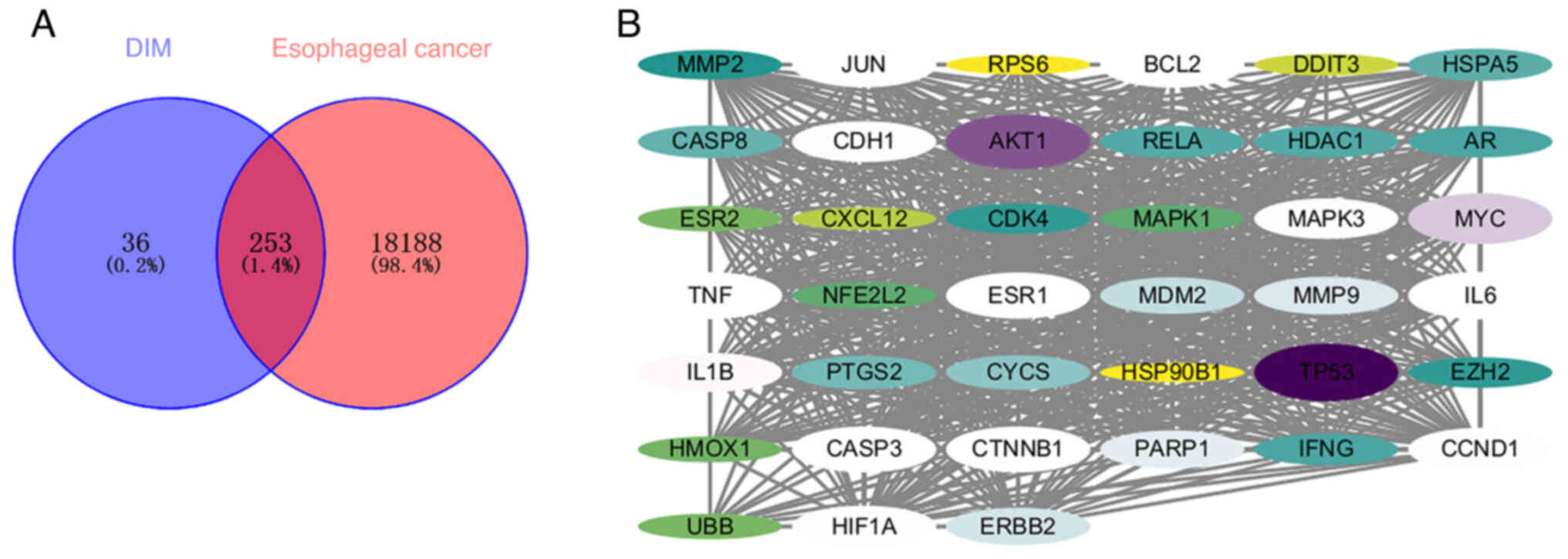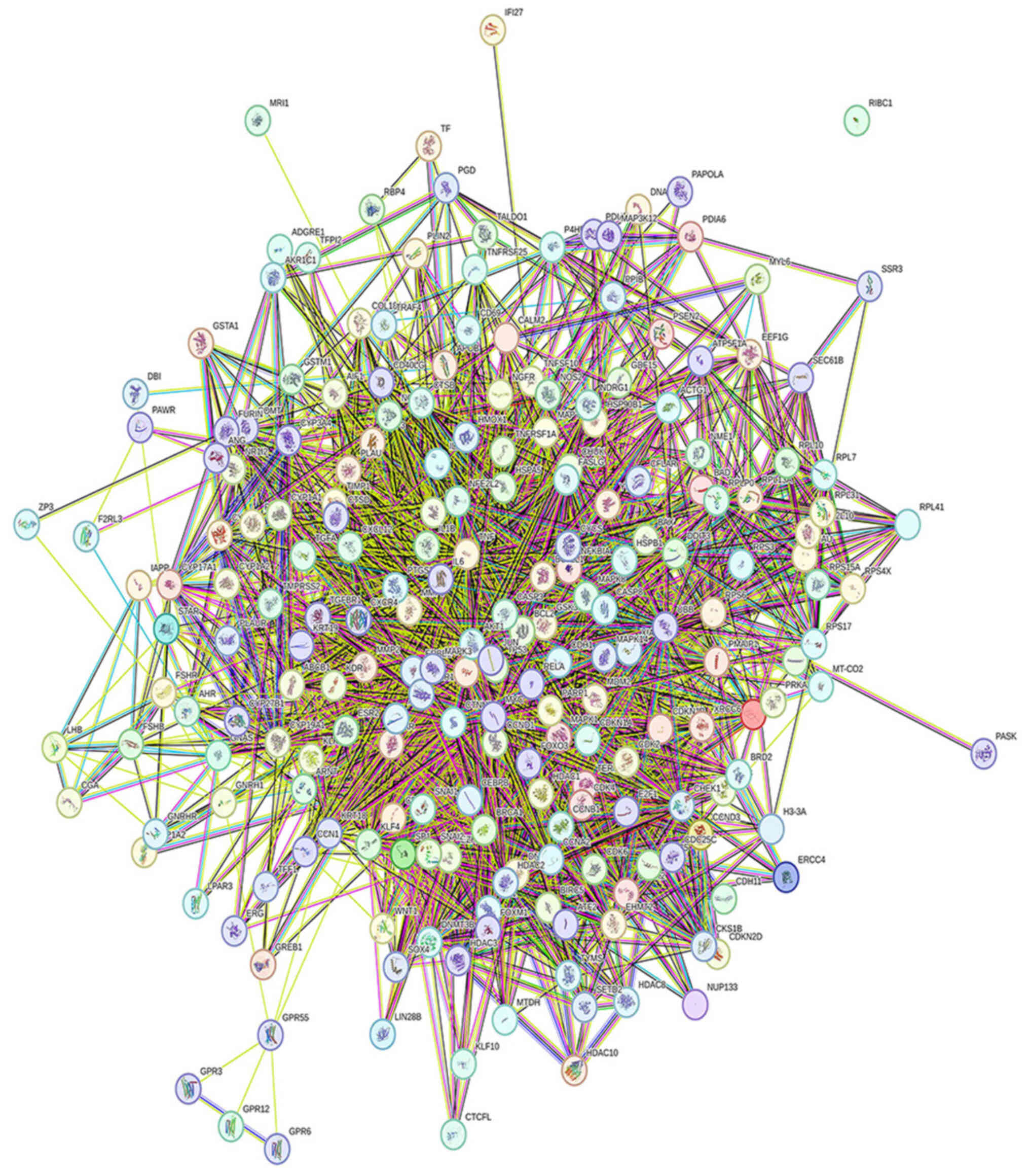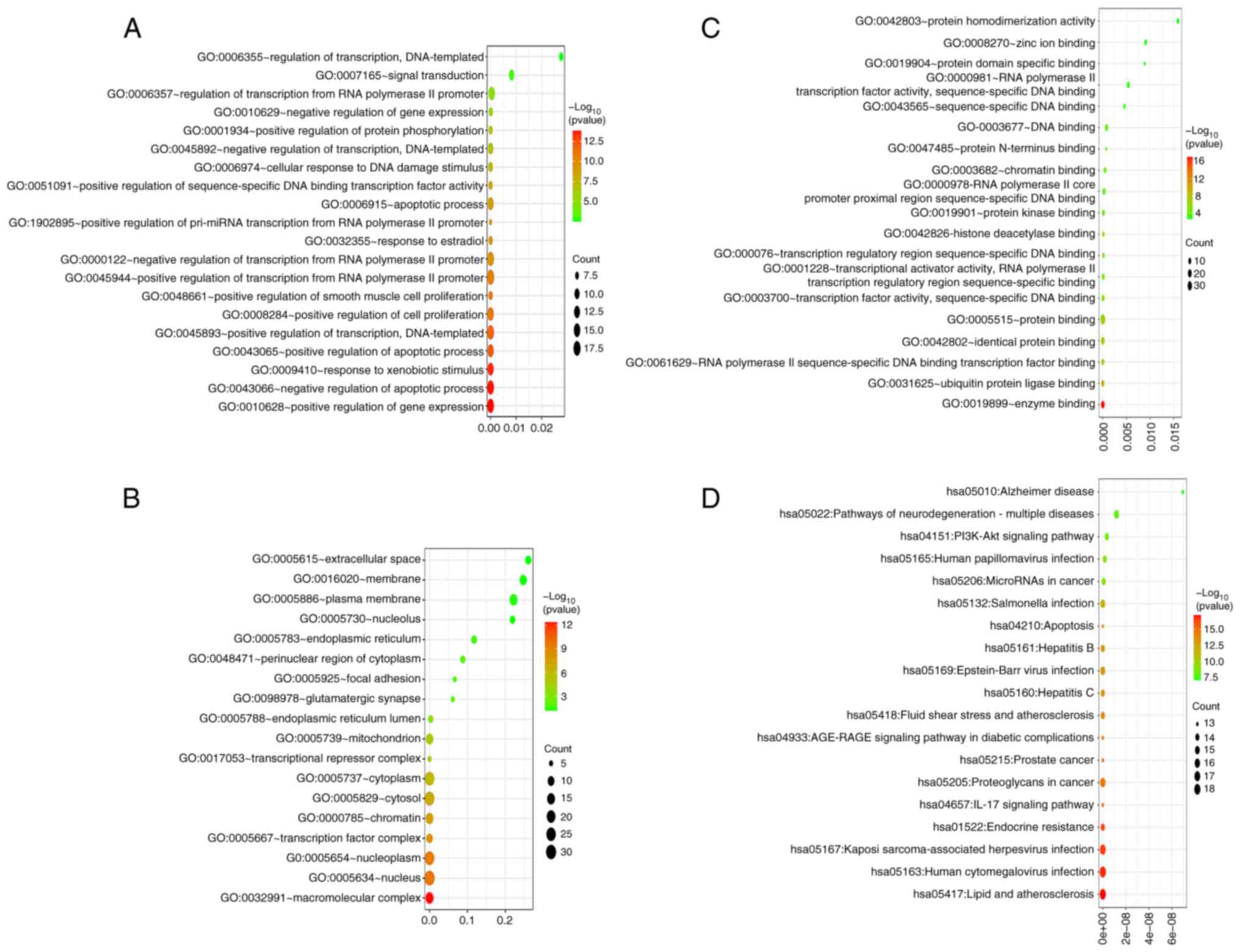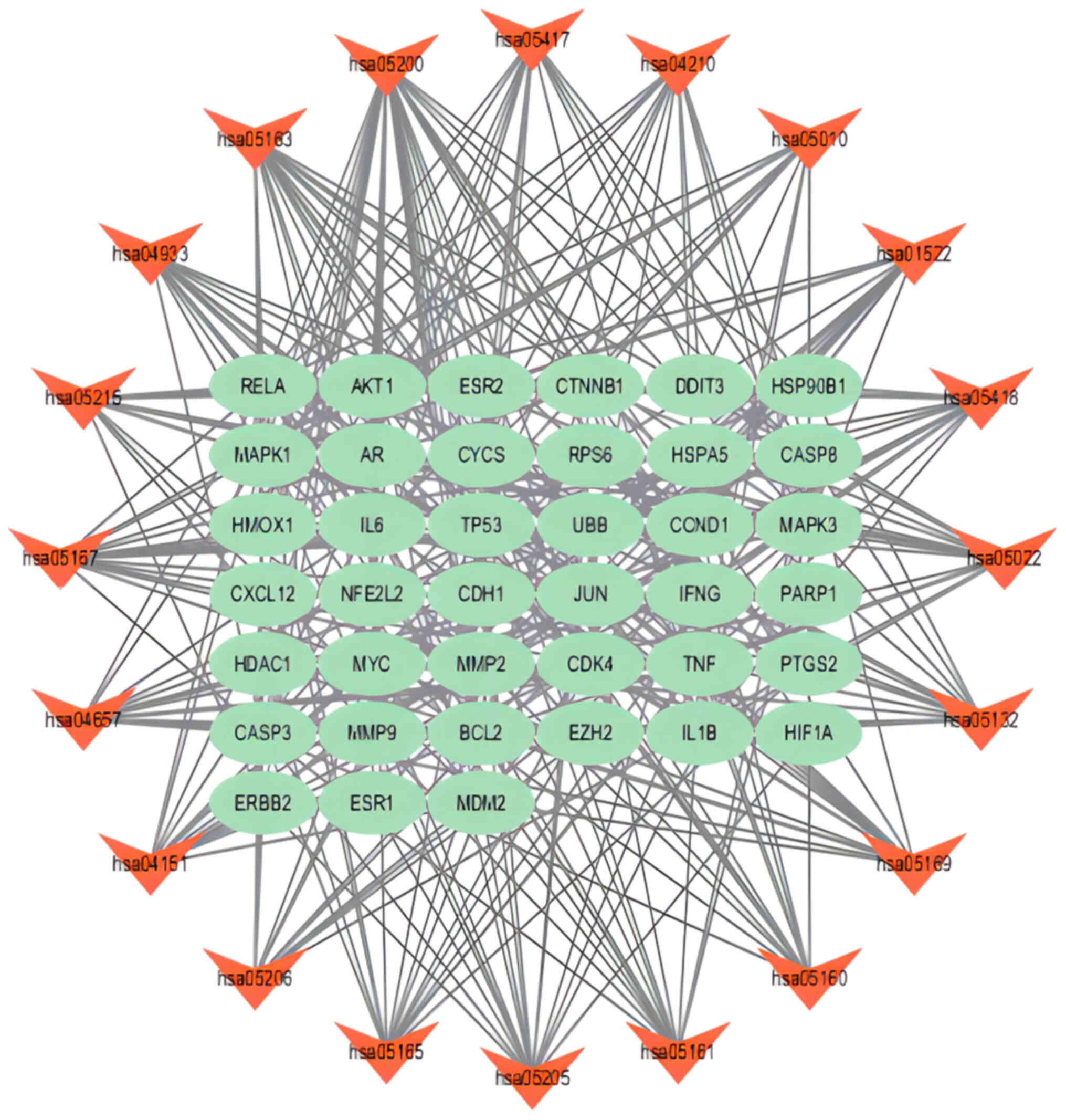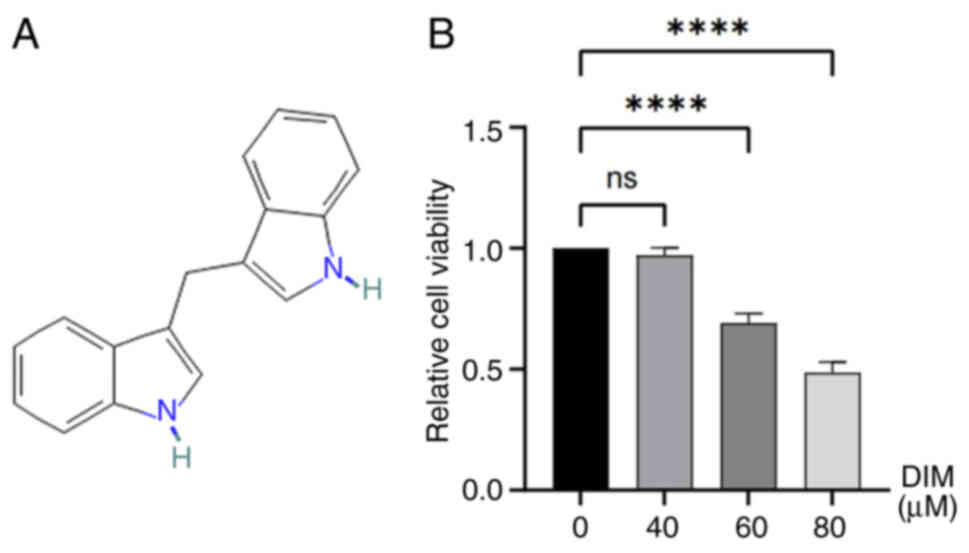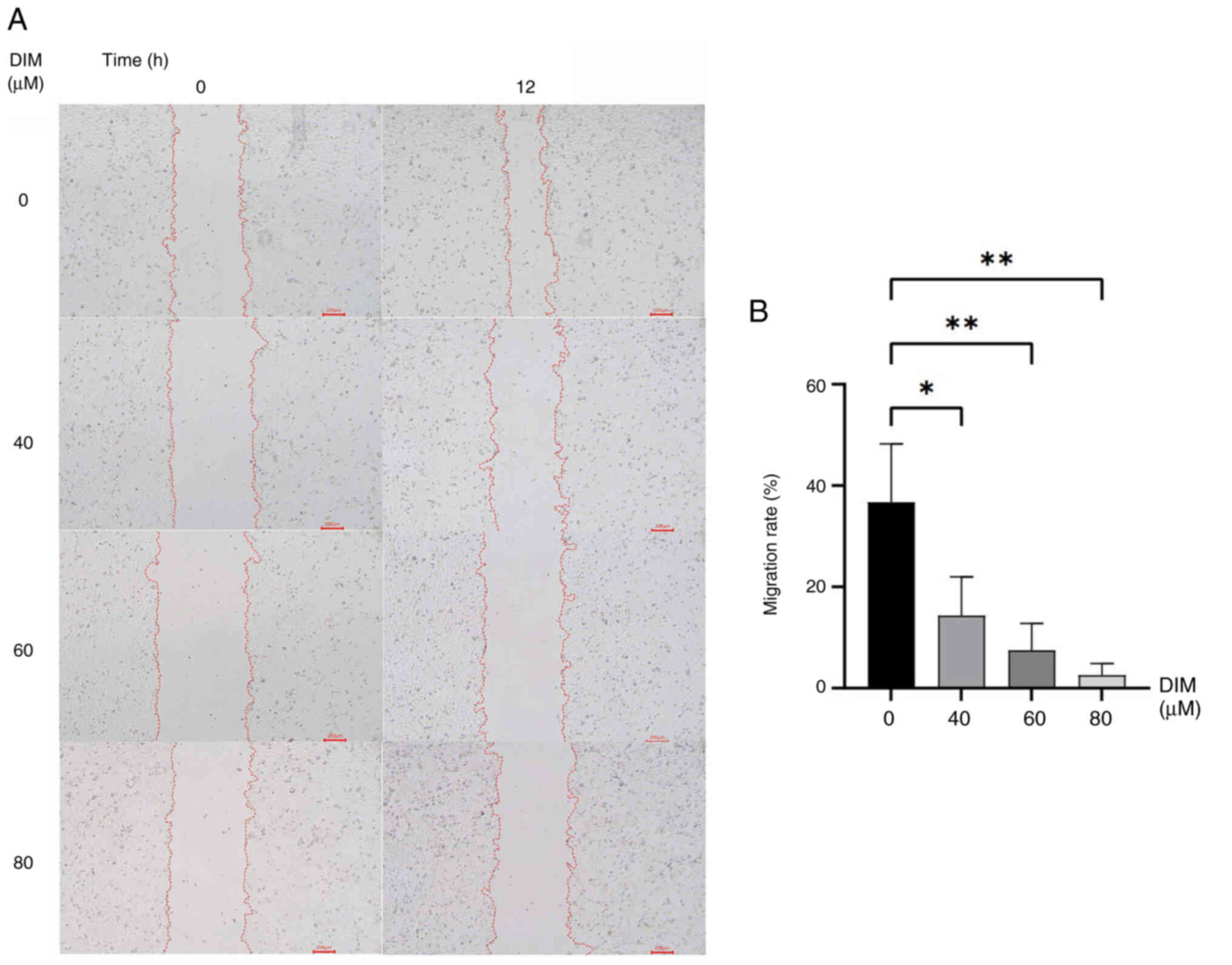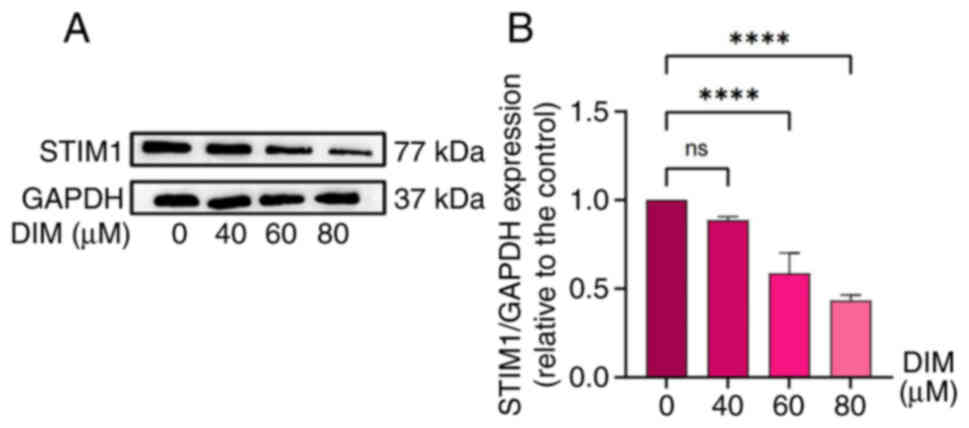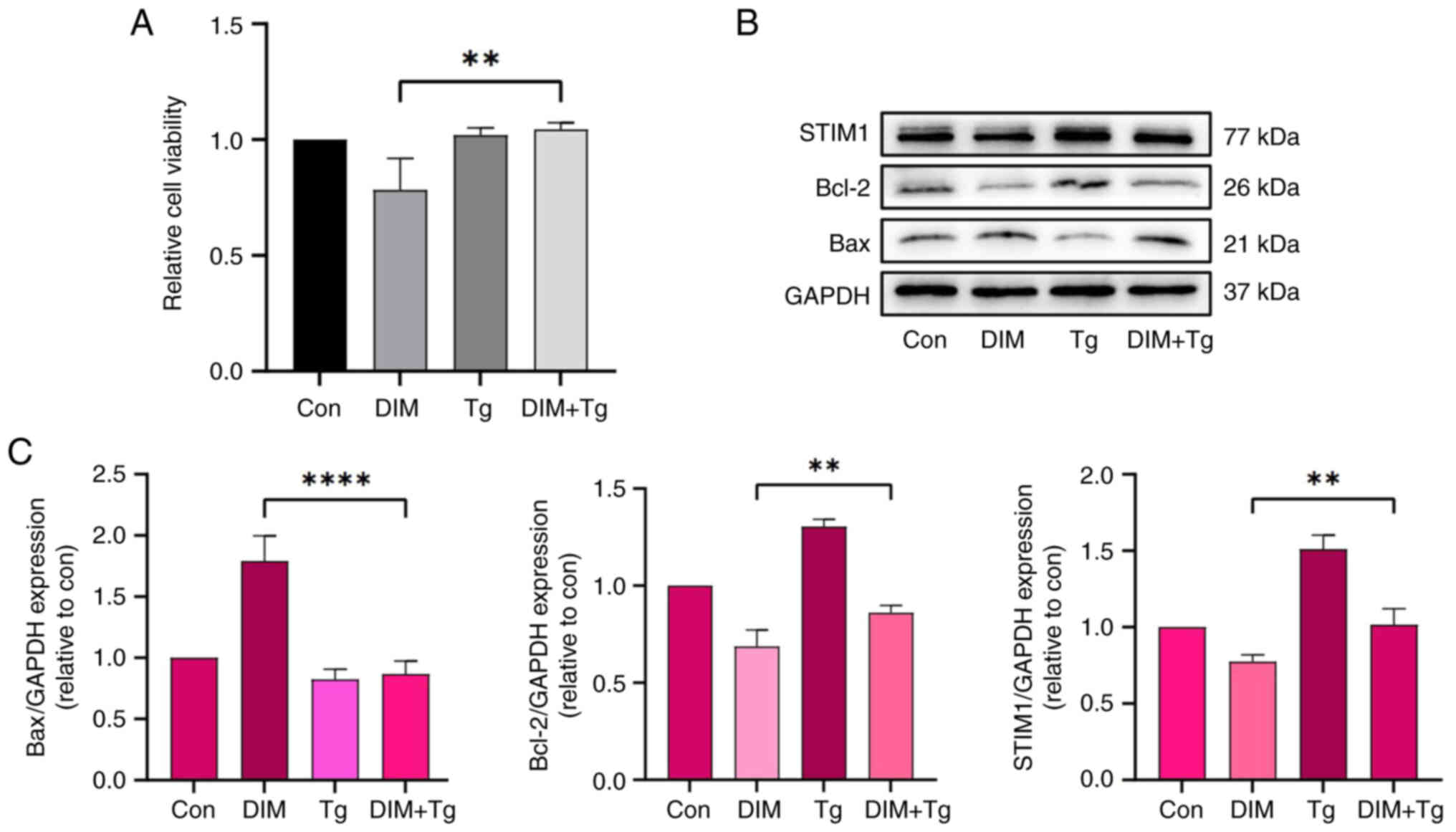3,3'-Diindolylmethane inhibits the proliferation of esophageal squamous cell carcinoma cells via downregulation of STIM1
- Authors:
- Published online on: May 28, 2024 https://doi.org/10.3892/ol.2024.14473
- Article Number: 339
-
Copyright: © Xiong et al. This is an open access article distributed under the terms of Creative Commons Attribution License.
Abstract
Introduction
Esophageal cancer is a common malignant tumor of the gastrointestinal tract, the eighth most common malignant tumor and the sixth leading cause of cancer-related death worldwide (1). With the development of minimally invasive techniques, minimally invasive surgery now occupies an absolute position in esophageal cancer surgery. Esophageal squamous cell carcinoma is dominant in East Asia, including China, while esophageal adenocarcinoma is dominant in Europe, which may be related to genetic susceptibility between different ethnicities and dietary conditions among different populations (2). Patients with esophageal cancer often only present with progressive dysphagia in the middle and late stages of disease due to the lack of specific clinical manifestations. Therefore, when patients present at the clinic, the indication for direct surgery has typically past, and even if surgery is possible, there is a risk of local and distant metastasis, which greatly increases the tumor burden on patients (3,4). With the development of neoadjuvant therapy in recent years, neoadjuvant therapy to achieve tumor shrinkage or even downstaging before surgery (thus increasing the radical resection rate of tumors) has become the optimal treatment option for patients with intermediate to advanced esophageal cancer (5). However, neoadjuvant therapy often causes adverse effects in patients, including anemia and hypoproteinemia (6), and a study has indicated that patients undergoing surgery following neoadjuvant therapy have an increased risk of pulmonary infection and anastomotic fistula (7). Therefore, it is particularly important to find a low-cost modality with few side effects to prevent or treat esophageal cancer.
Stromal interaction molecule 1 (STIM1) is a protein mainly found in the endoplasmic reticulum membrane and has a highly conserved protein structure (8). STIM1 is one of the key proteins of the store-operated calcium entry (SOCE) channel, which mediates the entry of extracellular Ca2+ into the intracellular compartment to maintain the relative stability of Ca2+ inside and outside the cell. When the calcium pool is emptied for various reasons, such as drug action and hypoxia (9), Ca2+ dissociates from the EF-chiral structure (structural domain of STIM1), which induces a multimerization process in the N-terminal region of STIM1, resulting in a conformational change of STIM1 and its transfer to the inner cell membrane to couple with Orai1 and transient receptor potential canonical channels, thereby activating SOCE to allow the entry of extracellular Ca2+ into the intracellular compartment (10,11). STIM1 has a close relationship with a variety of tumorigenesis mechanisms; it can participate in the recruitment of endothelial cells by the bone marrow, thus promoting tumor angiogenesis (12), and downregulation of the STIM1 gene blocks the cell cycle in the S or G2 phase (13). It has also been shown that STIM1 expression is related to the differentiation and prognosis of esophageal malignant tumors, and the higher the expression of STIM1, the worse the prognosis, while downregulation of STIM1 expression significantly inhibits the proliferation and migration of esophageal cancer cells (14).
3,3′-Diindolylmethane (DIM; molecular formula, C17H14N2; molecular weight, 246.3065) is a natural plant compound derived from cruciferous plants, including cauliflower and broccoli, and is a metabolite of indole-3-carbinol (I3C). After entering the digestive tract, I3C from cruciferous plants is readily hydrolyzed to DIM under acidic conditions to exert its biological effects (15). It has been demonstrated that DIM has antitumor activity against breast, nasopharyngeal, gastric and ovarian cancer (16,17). DIM can induce gastric cancer cell death by upregulating the expression of STIM1 protein (18), and it has been reported that DIM enhances sensitivity to radiotherapy in human esophageal cancer cells (19). However, whether DIM can directly inhibit the proliferation of esophageal cancer cells and through what possible pathway, and whether it can be regulated by STIM1 protein, has been rarely reported.
In the present study, the Cell Counting Kit-8 assay was used to verify whether DIM could inhibit the variation of TE-1 cells, and western blotting was applied to detect the expression of STIM1, Bcl-2 and Bax protein after DIM acted on TE-1 cells, to preliminarily explore the possible mechanism behind this.
Materials and methods
Prediction of DIM and esophageal cancer targets
‘3,3′-diindolylmethane’ was searched in the Comparative Toxicogenomics Database (CTD; http://ctdbase.org/detail.go?type=chem&acc=C016392) and the GeneCards database (https://www.genecards.org/Search/Keyword?queryString=3,3%27-diindolylmethane), selecting ‘Homo sapiens’ as the species. The disease key words, ‘esophageal cancer’, were also searched in the CTD (https://ctdbase.org/detail.go?type=disease&acc=MESH%3AD004938) and GeneCards database (https://www.genecards.org/Search/Keyword?queryString=esophagus%20cancer). The results files were downloaded as Excel files. The DIM and esophageal cancer targets were stored in two different Excel files and any duplicated content within each file was deleted.
Construction and analysis of a target network
The DIM and esophageal cancer targets were imported into Venny 2.1.0 (https://bioinfogp.cnb.csic.es/tools/venny/) to obtain the common targets. The common targets were then imported into STRING V12.0 (https://cn.string-db.org/cgi/input.pl) for network analysis, selecting ‘Homo sapiens’ as the species. The results were downloaded and saved as a tsv file, which was imported into Cytoscape 3.9.1 (Oracle Corporation) for visualization. Next, the PPI results were imported into Cytoscape and the Centiscape 2.2 plug-in was used. ‘Degree’, ‘closeness’ and ‘betweenness’ were selected to analyze the results, and 39 possible core targets were obtained.
Gene ontology (GO) and Kyoto encyclopedia of genes and genomes (KEGG) pathway enrichment analyses
The common intersection targets of DIM and esophageal cancer were entered into the Database for Annotation, Visualization and Integrated Discovery (https://david.ncifcrf.gov/), selecting ‘Homo sapiens’ as the species, for GO enrichment [Molecular Function (MF), Biological Process (BP) and Cell Composition (CC)] and KEGG pathway analyses. P<0.05 was considered to indicate statistical significance. The selected data were arranged in descending order, and the first 20 results were imported into SRplot (https://www.bioinformatics.com.cn/) to produce bubble diagrams.
Chemicals and reagents
DIM (cat. no. D9568; MilliporeSigma) was dissolved in dimethylsulfoxide (99%) and prepared as a 100 mM stock solution, which was stored at 4°C. Thapsigargin (Tg; HY-13433; MedChemExpress),2-(2-Methoxy-4-nitrophenyl)-3-(4-nitrophenyl)-5-(2,4-disulfo-phenyl)-2H-tetrazole monosodium salt [Cell Counting Kit-8 (CCK-8)] and bicinchoninic acid (BCA) protein assay kit (cat. no. P0011) were purchased from Beyotime Institute of Biotechnology. Primary antibodies against STIM1 (1:1,000; cat. no. ab108994; Abcam), B-cell lymphoma-2 (Bcl-2; 1:1,000; cat. no. 3498S; CST Biological Reagents Co., Ltd.), Bax (1:1,000; cat. no. 50599-2-Ig; Proteintech Group, Inc.) and GAPDH (1:10,000; cat. no. ab8245; Abcam) were also purchased. Goat anti-rabbit HRP-conjugated (1:10,000; cat. no. ab6721) secondary antibody was purchased from Abcam.
Cell culture and drug treatment
The human TE-1 esophageal cancer cell line (esophageal squamous cell carcinoma; cat. no. TCHu 89) was purchased from The Cell Bank of Type Culture Collection of The Chinese Academy of Sciences. Cells were cultured in RPMI 1640 medium (Dalian Meilun Biology Technology Co., Ltd.), containing 20% fetal bovine serum (Shanghai ExCell Biology, Inc.), at 37°C in a 5% CO2 incubator. As according to the literature (18), TE-1 cells were treated with DIM at concentrations of 0, 40, 60 and 80 µM for 24 h. In addition, the STIM1 agonist toxic, Tg (1 µM), was used to pre-treat TE-1 cells for 10 min prior to DIM exposure.
CCK-8 assay
TE-1 cells (10,000 cells/well) were inoculated into 96-well plates and exposed to different concentrations of DIM (0, 40, 60 and 80 µM) for 24 h, once cells had sufficiently adherent to the wall of the plate. Then, 10 µl CCK-8 solution was incubated with the cells for 1 h at 37°C, protected from the light. The cell viability was evaluated by absorbance at 450 nm with a microplate reader.
Scratch test
TE-1 cells in the logarithmic growth phase were inoculated into 6-well plates. After 24 h of fully adherent cell growth, 200 µl pipette tips were used to draw a straight line through the cells with a width of ~1 mm, perpendicular to the plate surface. After washing the 6-well plate with PBS to remove non-adherent cells, different concentrations of DIM (0, 40, 60 and 80 µM) in serum-free medium were added to each well. The scratch width in each well was recorded under a light microscope at 0 and 12 h. The cell migration rate (%) was calculated as follows: (0 h scratch width-12 h scratch width)/0 h scratch width, and assessed using ImageJ V1.8.0 (National Institutes of Health).
Protein extraction and immunoblotting
After the TE-1 cells were washed 2–3 times with pre-cooled PBS (cat. no. MA0015; Dalian Meilun Biology Technology Co., Ltd.), the cells were lysed with cell lysis buffer (PMSF:RIPA, 1:100; PMSF cat. no. ST505; Beyotime Institute of Biotechnology; RIPA cat. no. P0013B; Beyotime Institute of Biotechnology). The resulting precipitate was scraped away and incubated on ice for 15 min, after which the supernatant was collected by centrifugation in an Eppendorf microcentrifuge at 4,747 × g for 15 min at 4°C. The protein content was detected by the BCA kit, and the total protein amount in each group was adjusted to a consistent amount using 5X loading buffer (cat. no. P0015L; Beyotime Institute of Biotechnology). Equal amounts of protein (50 mg) were subjected to 12% SDS-PAGE, then transferred to polyvinylidene difluoride membranes (cat. no. FFP22; Beyotime Institute of Biotechnology). The membranes were incubated with 5% skimmed milk [prepared in tris-buffered saline (TBS) containing 0.05% Tween-20] at room temperature for 2 h, and then with STIM1, Bax, Bcl-2 and GAPDH antibodies at 4°C overnight. The membranes were then incubated with the corresponding secondary antibody for 1 h at 4°C. All primary and secondary antibodies were diluted with TBS containing 0.1% Tween-20 at 4°C. Protein bands were visualized using BeyoECL Plus (cat. no. P0018S; Beyotime Institute of Biotechnology) and analyzed by ImageJ V1.8.0 (National Institutes of Health).
Statistical analysis
Each experiment was repeated three times to obtain more stable results. Statistical analysis was performed using GraphPad Prism 9.0 (Dotmatics). The results are presented as the mean ± SD. One-way ANOVA or Kruskal-Wallis followed by the Tukey or Nemenyi test post hoc tests, respectively, were used to assess the significant differences between groups. P<0.05 was considered to indicate a statistically significant difference.
Results
DIM and esophageal cancer protein interaction network
Through the retrieval of data from relevant databases, a total of 289 potential targets of DIM and 18,441 potential esophageal cancer targets were obtained. Through cross-analysis, 253 cross-targets were identified (Fig. 1A). To further determine the possible core targets of DIM acting on esophageal cancer cells, STRING was used to construct a protein-protein interaction (PPI) network of related cross-targets (Fig. 2). Next, the PPI results were imported into Cytoscape and the Centiscape 2.2 plug-in was used to analyze the results, and 39 possible core targets were obtained (Fig. 1B).
GO and KEGG pathway enrichment analyses
The GO-BP results showed that core targets mainly involved biological processes such as ‘cell transcription’, ‘signal transduction’, ‘RNA polymerase II regulation’, ‘apoptosis regulation’ and ‘smooth muscle cell proliferation regulation’ (Fig. 3A). The GO-CC results showed that core targets mainly involved cell components such as ‘nucleolus’, ‘endoplasmic reticulum’, ‘cytoplasm’ and ‘chromatin’ (Fig. 3B). The GO-MF results showed that core targets mainly involved molecular functions such as ‘protein homodimerization activity’, ‘chromatin binding’, ‘protein kinase binding’ and ‘ubiquitin protein ligase binding’ (Fig. 3C). The KEGG results showed that core targets were involved in a number of neurodegenerative diseases, ‘PI3K-Akt signaling pathway’, ‘Prostate cancer’, ‘Apoptosis’, ‘IL-17 signaling pathway’ and ‘Lipid and atherosclerosis’ (Fig. 3D). The network analysis of signaling pathways and core targets showed the relationship between target pathways and core targets. For example, the ‘PI3K-Akt signaling pathway’ was related to the expression of ‘Bcl-2’ (Fig. 4).
DIM inhibits the viability of TE-1 esophageal cancer cells
Cells in the logarithmic growth phase were incubated with different concentrations of DIM (0, 40, 60 and 80 µM) for 24 h, then the cell viability was detected by the CCK-8 method. The results showed that DIM decreased the cell viability of TE-1 esophageal cancer cells in a concentration-dependent manner, which was statistically significant at DIM concentrations of 60 and 80 µM (P<0.05; Fig. 5B).
DIM inhibits the migration of TE-1 cells
To verify the effect of DIM on the migration of TE-1 cells, a scratch assay was used. The results showed that DIM inhibited the migration of TE-1 cells in a concentration-dependent manner, which was statistically significant at DIM concentrations of 40, 60 and 80 µM (P<0.05; Fig. 6A and B).
DIM promotes apoptosis in TE-1 cells
To investigate the way in which DIM affects TE-1 esophageal cancer cell viability, the cells were treated with different concentrations of DIM (0, 40, 60 and 80 µM) for 24 h, then the protein expression levels of Bcl-2 and Bax were analyzed by western blotting. The results showed that DIM induced a concentration-dependent decrease in Bcl-2 protein expression in TE-1 cells, while it caused a concentration-dependent increase in Bax protein expression, both of which were statistically significant at DIM concentrations of 60 and 80 µM (P<0.05; Fig. 7A-C).
DIM upregulates the expression of STIM1 protein
The results of network pharmacology suggested that DIM may affect esophageal cancer cells by regulating the PI3K-Akt pathway. Endoplasmic reticulum stress is the upstream pathway of the PI3K-Akt pathway, and STIM1 is one of the key proteins of endoplasmic reticulum stress (20). Therefore, STIM1 was used as the next research object in the present study. While determining whether DIM could promote apoptosis, at the same time, the changes in STIM1 expression in TE-1 human esophageal cancer cells treated with different concentrations of DIM (0, 40, 60 and 80 µM) were also investigated using western blotting. The results showed that DIM downregulated the expression of STIM1 protein with a certain concentration dependence, which was statistically significant at DIM concentrations of 60 and 80 µM (Fig. 8A and B).
Tg counteracts the changes to STIM1, Bcl-2 and Bax protein levels included by DIM in TE-1 cells
Based on the aforementioned results, to further verify whether DIM promotes apoptosis and inhibits the viability of TE-1 cells by downregulating the expression of STIM1, cells were co-treated with Tg (to upregulate the expression of STIM1) and 80 µM DIM. After detecting cell viability using CCK-8, it was found that the inhibition effect of DIM on TE-1 cells was reverted, which was statistically significant (P<0.05; Fig. 9A). Following upregulation of STIM1 using Tg, the downregulation of bcl-2 and STIM1 was alleviated, while the role of bax expression was suppressed compared with that in the DIM group, and the differences were statistically significant (P<0.05; Fig. 9B and C).
Discussion
Esophageal cancer is a highly aggressive gastrointestinal tumor and, since the clinical manifestations of patients in the early stage of disease are not typical, patients are often in the middle to late stages when they present with obvious symptoms. This leads to a poor prognosis if treating with surgery alone; therefore, comprehensive treatment of esophageal cancer has become the standard treatment option (21). However, the adverse effects of conventional neoadjuvant therapy may aggravate the tumor burden of patients further (6,7). In the present study, it was found that DIM, a natural phytochemical from cruciferous plants, induced apoptosis and inhibited the viability of esophageal cancer cells by downregulating the expression of STIM1, which provides a new theoretical direction for the early prevention and treatment of esophageal cancer using DIM.
Through KEGG analysis, it was found that DIM may be involved in the apoptosis, IL-17 and PI3K-Akt signaling pathways. A study has shown that TP53 and IL-17 can affect the proliferation and migration of esophageal cancer cells (22). Furthermore, PI3K-Akt can affect the proliferation, invasion and metastasis of a variety of tumor cells. A number of mutations in PI3K-Akt are known to exist in patients with esophageal cancer, and inhibition of the PI3K-Akt pathway can reduce the resistance of esophageal cancer to chemotherapy drugs (23–25). In addition, the PI3K-Akt pathway can inhibit endoplasmic reticulum stress and induce cell death (26). STIM1 participates in the stability of Ca2+ in the endoplasmic reticulum and participates in endoplasmic reticulum stress (27). Therefore, in the present study, the upstream regulatory signal of the PI3K-Akt pathway-endoplasmic reticulum stress signal, represented by STIM1, was studied to determine the effect of DIM on esophageal cancer cells (20). As a powerful pharmacological analysis tool, network pharmacology fully integrates the knowledge of system biology, pharmacology, information networks and computer science to explain the relationship between drugs, diseases, and argets (28). However, there were some limitations to the pharmacology network analysis performed in the present study. Due to the different inclusion criteria of studies, the comparability, integrity and reliability of data may differ between different databases, which may lead to certain differences in the relationship between data from different sources and between drugs and disease targets. In addition, the relationship between drug targets and disease targets is constantly updated, which may lead to a certain deviation in the results of the database. This may explain why STIM1 was not among the identified core targets.
Apoptosis is a type of programmed cell death. The Bcl-2 gene family is one of the important factors that causes apoptosis through the mitochondrial pathway, and Bax is one of its important members (29). Both Bcl-2 and Bax are located in the mitochondria and endoplasmic reticulum. The enhanced expression of Bcl-2 can promote cell apoptosis, while Bax has the opposite effect (29,30). In the present study, western blotting was used to demonstrate that DIM downregulated the expression of Bcl-2 and upregulated the expression of Bax in a concentration-dependent manner. After stimulation of STIM1 expression with Tg, this effect was prevented.
Through GO analysis, it was found that DIM may act on cellular components such as the endoplasmic reticulum. STIM1 is a transmembrane Ca2+-binding phosphoprotein located on the endoplasmic reticulum membrane. STIM1 acts as a Ca2+ sensor in the endoplasmic reticulum cavity and participates in the regulation of the SOCE pathway (31). Studies have shown that SOCE has a certain role in the occurrence and development of tumors. In breast cancer cells, α-glucosidase inhibitors can significantly reduce the expression level of STIM1, thereby weakening the expression of SOCE to inhibit breast cancer cell viability (32). In addition, downregulation of STIM1 expression can inhibit the migration and invasion of thyroid cancer cells, and it can restore the expression of thyroid-stimulating hormone receptors (33). Tg is an irreversible endoplasmic reticulum Ca2+-ATPase binder, which can induce endoplasmic reticulum protein folding disorder, leading to the accumulation of unprocessed proteins in the endoplasmic reticulum. This causes dysfunction of the endoplasmic reticulum and activation of SOCE, which is typically regarded as an agonist of endoplasmic reticulum stress (34). STIM1 is one of the key proteins of SOCE. Tg can empty the endoplasmic reticulum Ca2+ pool, thereby indirectly activating the expression of STIM1, which leads to extracellular Ca2+ entering the cell to maintain the balance of intracellular and extracellular Ca2+ (35). Therefore, Tg can be regarded as an agonist of STIM1 protein. In the present study, the expression of STIM1 protein in TE-1 cells pretreated with Tg was restored compared with that of DIM alone. Therefore, we hypothesize that DIM can overload Ca2+ in the endoplasmic reticulum of TE-1 human esophageal cancer cells, thus causing apoptosis of these cells. However, further research is required to confirm this.
However, there are still some shortcomings to the present study. The aim of the present study was limited to the examination of esophageal squamous cell carcinoma and did not involve other pathological types of esophageal cancer. In addition, the present study only included experiments at the cellular level and was not extended to experimental mice and patients. The present study preliminarily verified that DIM affected the oncology-related characteristics of esophageal cancer cells by regulating the expression of STIM1 protein, which is a transmembrane protein located on the endoplasmic reticulum membrane that regulates calcium homeostasis. However, whether there is a change in the concentration of Ca2+ inside and outside of the endoplasmic reticulum during the anti-esophageal cancer activity of DIM requires further study. In addition, whether other tumor suppression methods, such as ferroptosis and pyroptosis, are influenced by DIM still needs further exploration. It has also been demonstrated that DIM has reproductive toxicity in mice, that is, it can inhibit the secretion of related sex hormones in male mice, thereby reducing the quality of sperm (36). At present, study of the antitumor activity of DIM remains in the cell and animal experiments stage, and no drugs for human consumption have been developed. However, DIM-related side effects still need to be further confirmed by a large number of clinical experiments after careful evaluation by pharmacologists and physicians.
In conclusion, the results of the present study indicated that DIM promoted apoptosis and inhibited the viability of esophageal cancer cells by downregulating the expression of STIM1. Therefore, the natural phytochemical, DIM, may be a potential substance for the early prevention and treatment of esophageal cancer cells.
Acknowledgements
Not applicable.
Funding
Funding: No funding was received.
Availability of data and materials
The data generated in the present study may be requested from the corresponding author.
Authors' contributions
CX YY, FL and YT designed the study. CX, YT FL, YY and XL assisted with the data analyses. CX, XL and JL performed western blotting. CX and SD performed the CCK-8 assay. CX and SD performed the scratch test. CX wrote the initial draft of the manuscript. CX and XL contributed to the analysis and interpretation of the data. FL and YY assisted in the preparation and critical review of the manuscript. CX YY, FL and YT confirm the authenticity of all the raw data. All authors agreed to be accountable for all aspects of the work. All authors read and approved the final version of the manuscript.
Ethics approval and consent to participate
Not applicable.
Patient consent for publication
Not applicable.
Competing interests
The authors declare that they have no competing interests.
References
|
Kamangar F, Nasrollahzadeh D, Safiri S, Sepanlou SG, Fitzmaurice C, Ikuta KS, Bisignano C, Islami F, Roshandel G, Lim SS, et al: The global, regional, and national burden of oesophageal cancer and its attributable risk factors in 195 countries and territories, 1990–2017: A systematic analysis for the global burden of disease study 2017. Lancet Gastroenterol Hepatol. 5:582–597. 2020. View Article : Google Scholar | |
|
Chen W, Zheng R, Zhang S, Zeng H, Fan Y, Qiao Y and Zhou Q: Esophageal cancer incidence and mortality in China, 2010. Thorac Cancer. 5:343–348. 2014. View Article : Google Scholar : PubMed/NCBI | |
|
Jung HK, Tae CH, Lee HA, Lee H, Don Choi K, Park JC, Kwon JG, Choi YJ, Hong SJ, Sung J, et al: Treatment pattern and overall survival in esophageal cancer during a 13-year period: A nationwide cohort study of 6,354 Korean patients. PLoS One. 15:e02314562020. View Article : Google Scholar : PubMed/NCBI | |
|
Uhlenhopp DJ, Then EO, Sunkara T and Gaduputi V: Epidemiology of esophageal cancer: Update in global trends, etiology and risk factors. Clin J Gastroenterol. 13:1010–1021. 2020. View Article : Google Scholar : PubMed/NCBI | |
|
Shah MA, Kennedy EB, Catenacci DV, Deighton DC, Goodman KA, Malhotra NK, Willett C, Stiles B, Sharma P, Tang L, et al: Treatment of locally advanced esophageal carcinoma: ASCO guideline. J Clin Oncol. 38:2677–2694. 2020. View Article : Google Scholar : PubMed/NCBI | |
|
Herzberg J, Strate T, Guraya SY and Honarpisheh H: Risk factors for anastomotic leakage after surgical resections for esophageal cancer. Langenbecks Arch Surg. 406:1859–1866. 2021. View Article : Google Scholar : PubMed/NCBI | |
|
Schröder W, Raptis DA, Schmidt HM, Gisbertz SS, Moons J, Asti E, Luyer MDP, Hölscher AH, Schneider PM, Berge Henegouwen MI, et al: Anastomotic techniques and associated morbidity in total minimally invasive transthoracic esophagectomy: Results from the EsoBenchmark database. Ann Surg. 270:820–826. 2019. View Article : Google Scholar : PubMed/NCBI | |
|
Collins SR and Meyer T: Evolutionary origins of STIM1 and STIM2 within ancient Ca2+ signaling systems. Trends Cell Biol. 21:202–211. 2011. View Article : Google Scholar : PubMed/NCBI | |
|
Stathopulos PB, Li GY, Plevin MJ, Ames JB and Ikura M: Stored Ca2+ depletion-induced oligomerization of stromal interaction molecule 1 (STIM1) via the EF-SAM region: An initiation mechanism for capacitive Ca2+ entry. J Biol Chem. 281:35855–35862. 2006. View Article : Google Scholar : PubMed/NCBI | |
|
Thompson JL and Shuttleworth TJ: Molecular basis of activation of the arachidonate-regulated Ca2+ (ARC) channel, a store-independent Orai channel, by plasma membrane STIM1. J Physiol. 591:3507–3523. 2013. View Article : Google Scholar : PubMed/NCBI | |
|
Zheng L, Stathopulos PB, Schindl R, Li GY, Romanin C and Ikura M: Auto-inhibitory role of the EF-SAM domain of STIM proteins in store-operated calcium entry. Proc Natl Acad Sci USA. 108:1337–1342. 2011. View Article : Google Scholar : PubMed/NCBI | |
|
Lodola F, Laforenza U, Bonetti E, Lim D, Dragoni S, Bottino C, Ong HL, Guerra G, Ganini C, Massa M, et al: Store-operated Ca2+ entry is remodelled and controls in vitro angiogenesis in endothelial progenitor cells isolated from tumoral patients. PLoS One. 7:e425412012. View Article : Google Scholar : PubMed/NCBI | |
|
Abdullaev IF, Bisaillon JM, Potier M, Gonzalez JC, Motiani RK and Trebak M: Stim1 and Orai1 mediate CRAC currents and store-operated calcium entry important for endothelial cell proliferation. Circ Res. 103:1289–1299. 2008. View Article : Google Scholar : PubMed/NCBI | |
|
Tang J, Ye SF, Wang MQ, Li J, Meng X and Liu F: Stromal interaction molecule 1 promotes tumor growth in esophageal squamous cell carcinoma. Genomics. 112:2146–2153. 2020. View Article : Google Scholar : PubMed/NCBI | |
|
Kim HW, Kim J, Kim J, Lee S, Choi BR, Han JS, Lee KW and Lee HJ: 3,3′-Diindolylmethane inhibits lipopolysaccharide-induced microglial hyperactivation and attenuates brain inflammation. Toxicol Sci. 137:158–167. 2014. View Article : Google Scholar : PubMed/NCBI | |
|
Lee GA, Hwang KA and Choi KC: Inhibitory effects of 3,3′-diindolylmethane on epithelial-mesenchymal transition induced by endocrine disrupting chemicals in cellular and xenograft mouse models of breast cancer. Food Chem Toxicol. 109:284–295. 2017. View Article : Google Scholar : PubMed/NCBI | |
|
Li F, Xu Y, Chen C, Chen SM, Xiao BK and Tao ZZ: Pro-apoptotic and anti-proliferative effects of 3,3′-diindolylmethane in nasopharyngeal carcinoma cells via downregulation of telomerase activity. Mol Med Rep. 12:3815–3820. 2015. View Article : Google Scholar : PubMed/NCBI | |
|
Ye Y, Li X, Wang Z, Ye F, Xu W, Lu R, Shen H and Miao S: 3,3′-Diindolylmethane induces gastric cancer cells death via STIM1 mediated store-operated calcium entry. Int J Biol Sci. 17:1217–1233. 2021. View Article : Google Scholar : PubMed/NCBI | |
|
Wang G: Radiosensitizing effect of 3,3′-diindolylmethane on human esophageal cancer Eca109 cell line and its mechanism (unpublished PhD thesis). Bengbu Medical College. 2014. | |
|
Huang Z: The apparent molecular mechanism of artesunate regulating endoplasmic reticulum stress-PI3K-AKT inhibiting colorectal cancer (unpublished PhD thesis). Guangzhou University of Traditional Chinese Medicine. 2018. | |
|
Lu Z, Wang J, Shu Y, Liu L, Kong L, Yang L, Wang B, Sun G, Ji Y, Cao G, et al: Sintilimab versus placebo in combination with chemotherapy as first line treatment for locally advanced or metastatic oesophageal squamous cell carcinoma (ORIENT-15): Multicentre, randomised, double blind, phase 3 trial. BMJ. 377:e0687142022. View Article : Google Scholar : PubMed/NCBI | |
|
Ye F, Song J, Wang Y, Xu X and Zhang K: Proliferation potential-related protein promotes the esophageal cancer cell proliferation, migration and suppresses apoptosis by mediating the expression of p53 and interleukin-17. Pathobiology. 85:322–331. 2018. View Article : Google Scholar : PubMed/NCBI | |
|
Fattahi S, Amjadi-Moheb F, Tabaripour R, Ashrafi GH and Akhavan-Niaki H: PI3K/AKT/mTOR signaling in gastric cancer: Epigenetics and beyond. Life Sci. 262:1185132020. View Article : Google Scholar : PubMed/NCBI | |
|
Li B, Li J, Xu WW, Guan XY, Qin YR, Zhang LY, Law S, Tsao SW and Cheung ALM: Suppression of esophageal tumor growth and chemoresistance by directly targeting the PI3K/AKT pathway. Oncotarget. 5:11576–11587. 2014. View Article : Google Scholar : PubMed/NCBI | |
|
Luo Q, Du R, Liu W, Huang G, Dong Z and Li X: PI3K/Akt/mTOR signaling pathway: Role in esophageal squamous cell carcinoma, regulatory mechanisms and opportunities for targeted therapy. Front Oncol. 12:8523832022. View Article : Google Scholar : PubMed/NCBI | |
|
Hu P, Han Z, Couvillon AD and Exton JH: Critical role of endogenous Akt/IAPs and MEK1/ERK pathways in counteracting endoplasmic reticulum stress-induced cell death. J Biol Chem. 279:49420–49429. 2004. View Article : Google Scholar : PubMed/NCBI | |
|
Benson JC and Trebak M: Too much of a good thing: The case of SOCE in cellular apoptosis. Cell Calcium. 111:1027162023. View Article : Google Scholar : PubMed/NCBI | |
|
Barabási AL, Gulbahce N and Loscalzo J: Network medicine: A network-based approach to human disease. Nat Rev Genet. 12:56–68. 2011. View Article : Google Scholar : PubMed/NCBI | |
|
Paone S, Baxter AA, Hulett MD and Poon IKH: Endothelial cell apoptosis and the role of endothelial cell-derived extracellular vesicles in the progression of atherosclerosis. Cell Mol Life Sci. 76:1093–1106. 2019. View Article : Google Scholar : PubMed/NCBI | |
|
Zhao Y, Fu Y and Wang X: The effects of Xuebijing injection on apoptosis and the expression of regulatory factors including Bcl-2,Bax and Caspase-3 in the renal cells of rats with acute paraquat poisoning. Hebei Med J. 40:2889–2894. 2018. | |
|
Leech CA, Kopp RF, Nelson HA, Nandi J and Roe MW: Stromal interaction molecule 1 (STIM1) regulates ATP-sensitive potassium (KATP) and store-operated Ca2+ channels in MIN6 β-Cells. J Biol Chem. 292:2266–2277. 2017. View Article : Google Scholar : PubMed/NCBI | |
|
Jardin I, Lopez JJ, Salido GM and Rosado JA: Store-operated Ca2+ entry in breast cancer cells: Remodeling and functional role. Int J Mol Sci. 19:40532018. View Article : Google Scholar : PubMed/NCBI | |
|
Asghar MY, Lassila T, Paatero I, Nguyen VD, Kronqvist P, Zhang J, Slita A, Löf C, Zhou Y, Rosenholm J and Törnquist K: Stromal interaction molecule 1 (STIM1) knock down attenuates invasion and proliferation and enhances the expression of thyroid-specific proteins in human follicular thyroid cancer cells. Cell Mol Life Sci. 78:5827–5846. 2021. View Article : Google Scholar : PubMed/NCBI | |
|
Sposito S, Secondo A, Romanelli AM, Montefusco A, Nanayakkara M, Auricchio S, Barone MV, Caputo I and Paolella G: Peculiar Ca2+ homeostasis, ER stress, autophagy, and TG2 modulation in celiac disease patient-derived cells. Int J Mol Sci. 24:14952023. View Article : Google Scholar : PubMed/NCBI | |
|
Evinova A, Hatokova Z, Tatarkova Z, Brodnanova M, Dibdiakova K and Racay P: Endoplasmic reticulum stress induces mitochondrial dysfunction but not mitochondrial unfolded protein response in SH-SY5Y cells. Mol Cell Biochem. 477:965–975. 2022. View Article : Google Scholar : PubMed/NCBI | |
|
Aksu EH, Akman O, Ömür AD, Karakuş E, Can I, Kandemir FM, Dorman E and Uçar Ö: 3,3 Diindolylmethane leads to apoptosis, decreases sperm quality, affects blood estradiol 17 β and testosterone, oestrogen (α and β) and androgen receptor levels in the reproductive system in male rats. Andrologia. 48:1155–1165. 2016. View Article : Google Scholar : PubMed/NCBI |



